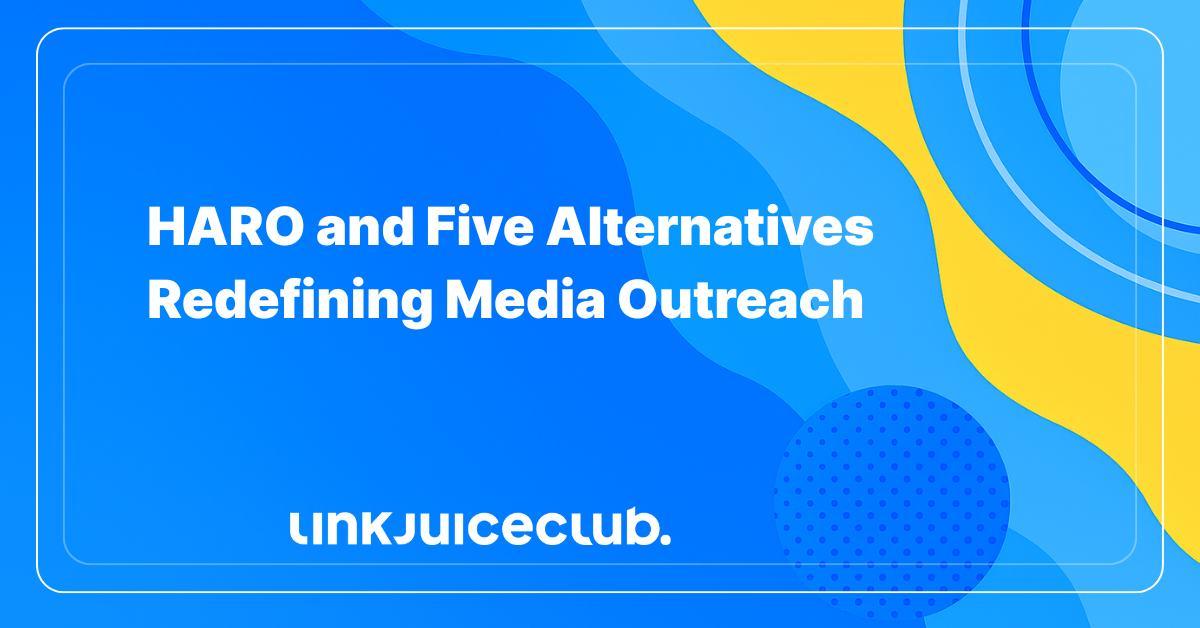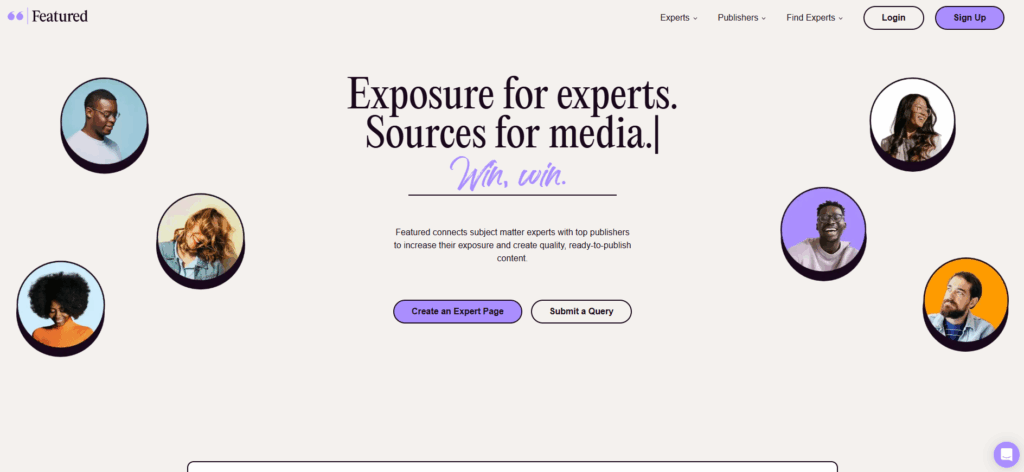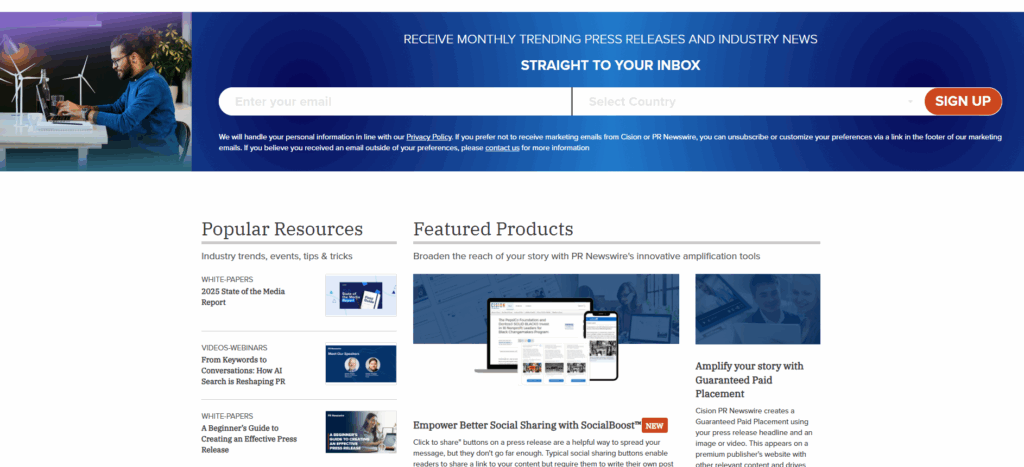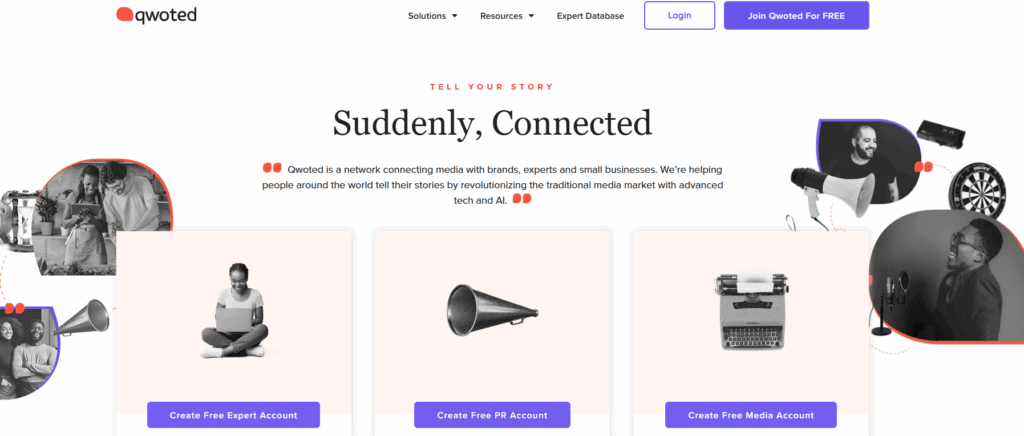
HARO and Five HARO Alternatives Redefining Media Outreach
Out of nowhere, the ghost of HARO has shuffled back into the room. After vanishing quietly at the end of 2024, the service got scooped up by Featured.com and re-entered the scene on April 15, 2025. A week later, the switch flipped back on. Whether it’s a full-blown comeback tour or just a soft reboot remains unclear. But while HARO took its nap, the rest of the media matchmaking world kept spinning and evolving fast.
Here’s the thing: HARO used to be the go-to shortcut for getting your name in lights. Journalists needed quotes. Experts wanted backlinks. The system paired them up like speed dating for credibility. It was noisy, messy, sometimes magic, and for many, completely indispensable.
But time moves on. And so do users. In HARO’s absence, a crop of new players stepped up, and some of them aren’t just alternatives. They’re upgrades. Leaner, sharper tools started stealing the spotlight while HARO was in hibernation.
Let’s be honest: HARO was never exactly a scalpel. More like a fishing net. You tossed your pitch in, hoped someone noticed, and crossed your fingers for a bite. The biggest wins came from tools that actually understood what niche expertise meant. Platforms that could whisper “here’s your perfect match” instead of yelling into the void.
What’s working now? Platforms that zone in on specific industries, giving you a clearer shot without the noise. Smarter query-matching that doesn’t treat a yoga instructor and a tax consultant as equally good fits. And most importantly, communities where journalists actually want to be, not ones where they’re buried under 93 irrelevant responses from people who just learned what “backlink” means.
So yes, HARO is technically breathing again. But whether it reclaims the crown is anyone’s guess. Meanwhile, the race for precision, speed, and real media value is heating up. And it might just be time to look beyond the old giant and start asking who’s really delivering the goods in 2025?
Read this Link Juice Club blog to find out more!
So, What Was HARO Really?
HARO, short for Help A Reporter Out, stepped in to solve a pretty simple problem. Reporters were constantly on the hunt for credible voices to quote. Meanwhile, professionals and businesses were eager to get their names out there. HARO made the introductions.
The whole thing kicked off back in 2008 as a humble email list. Nothing fancy. Just a string of requests landing in inboxes a few times a day. Each blast came packed with questions and queries across categories like tech, business, health, lifestyle, and plenty more.
If you had something useful to say, you could jump in. No velvet ropes, no PR gatekeeping. And when a pitch hit the mark, it could land you in anything from a household-name publication to an obscure but valuable niche blog.
At its height, HARO offered a remarkably easy way to snag media coverage, grab powerful backlinks, and build a bit of public trust. Whether you were shaping a personal brand or boosting a company profile, it gave you a shot without needing a press pass or a publicist.
From Media Darling to Digital Dustbin to Fully Ablaze
There was a time when HARO was the smoothest path into the big leagues of media coverage. Spot a reporter asking for expert input, send a clever reply, and if the stars aligned, you’d wind up featured on a site with serious clout. No need to spend a dime on ads. No cold emails begging for attention. Just being in the right inbox at the right time with something useful to say. It was link building wearing a blazer, and it got results.
Then came the flood. Submissions poured in from every corner of the internet. Automation tools got involved. Generic replies multiplied. Journalists were drowning in noise, and genuinely helpful responses got lost in the pile. Somewhere along the way, the name changed to “Connectively,” which didn’t help its popularity, and by the end of 2024, it quietly slipped off the radar.
Then April 2025 brought a twist. Featured.com stepped in, took over, and vowed to steer it back to its roots. Just one daily email. Real requests. Human voices instead of canned pitches. The SEO crowd is watching with cautious optimism, because if this reboot sticks, it could be the golden ticket all over again.
Why HARO Alternatives Deserve a Proper Look
HARO gave media outreach a new tempo. Journalists began asking questions publicly and experts replied with real insight. This daily rhythm changed how stories were sourced and who received credit. The simplicity created momentum, and that momentum shaped a brand-new corner of the internet.
Consultants, founders, and specialists found their way into major publications. Exposure no longer required press contacts or bloated marketing budgets. The method delivered more than visibility. It produced backlinks with serious SEO power and helped unknown names gain real authority.
This success gave rise to a new generation of platforms. Some improved targeting, others streamlined the process or built stronger communities. Each one took inspiration from HARO’s original playbook and started adding value in new ways.
The approach HARO made familiar now supports an entire landscape of media tools. These five HARO alternatives continue to help users share knowledge, gain recognition, and climb the rankings. HARO cleared the road and a new wave of platforms is stepping up to take the wheel.
1. Featured (formerly known as Terkel)

Featured feels like what HARO meant to be before the inbox avalanche. Instead of throwing every media request at everyone and seeing who flinches, it actually matches queries to your area of expertise. It’s selective in a way HARO never quite managed.
The platform adds some polish too. Responses are easy to send, results are trackable, and the whole thing runs with just enough gamification to keep you engaged without feeling like you’re earning badges in a loyalty program.
It’s especially handy for SEOs who want backlinks that look like journalism, not outreach stunts. And for experts who prefer relevance over roulette.
• Pricing: contact required
• Website: featured.com
• Mostly used by professionals who want to be quoted without competing with 200 AI-generated replies
Add to that a roster of media partners like Yahoo Finance, CMSWire, and MarTech, and you’ve got real visibility. Most links are dofollow and naturally placed, which means they actually help. HARO may have had more volume, but Featured has taste.
2. Prowly

Prowly isn’t here to send you a few queries and hope for the best. It’s what happens when someone takes a PR wish list and actually builds it. Global media contacts? Check. Press release builder? Built-in. CRM? Of course. AI that helps you write better pitches, faster? Naturally.
This is what HARO never grew into. While HARO was waiting for opportunities to show up, Prowly was helping teams create their own. Among HARO alternatives, it stands out for teams that need consistency, structure, and outreach that extends beyond a few reactive quotes.
If you like running experiments, the pitch tracker lets you see which messaging lands and which gets ignored. It’s a tool with systems thinking baked in, perfect for brands and agencies who’ve outgrown their inbox.
• Pricing: starts at €258 per month
• Website: prowly.com
• Mostly used by full-scale PR teams, agency workflows, and building a personalised media infrastructure
3. ProfNet

ProfNet isn’t built for volume-hunting or fast wins. It’s a premium tool for teams that treat media like strategy, not chance. Think direct access to journalists from CNN, Reuters, The Wall Street Journal, and respected industry publications.
Setup isn’t instant, and the pricing filters out anyone just dabbling in PR. But what you get is scale, trust, and coverage that carries real weight in enterprise-level comms.
There’s also a little agency trick in play here. One ProfNet account can cover multiple clients if you swap expert bios strategically. It’s doable. Just be subtle about it.
• Pricing: free for journalists, €1,650 per year for expert access
• Website: prnewswire.com/profnet
• Mostly used by enterprise PR teams, large-scale trust building, and clients who want headlines that stick
4. Qwoted

Qwoted gives you more than a list of requests. Each query comes with insight into how many others are already pitching, which makes it easier to focus where there’s actual room to stand out.
The platform includes a CRM that handles the mess. You can track responses, keep tabs on team assignments, and follow results without needing to export a single spreadsheet.
It also keeps you updated on media shifts. The Media Moves feature tracks which journalists are changing roles or publications, so your outreach lands in the right inbox.
• Pricing: free plan includes two pitches, paid plans start at €99 per month
• Website: qwoted.com
• Mostly used by freelancers, specialists, and media pros working within a defined niche
5. SourceBottle

SourceBottle keeps things simple. It’s designed for individuals and small teams who want exposure in local or lifestyle-driven markets without stacking tools or overspending. The platform prioritizes Australia and New Zealand, with some reach into UK-based lifestyle and small business media.
The interface is minimal, and the features are straightforward. You get alerts by niche, expert callouts, and options for product reviews or trial campaigns. It works well for those looking to build visibility with focus, not scale.
• Pricing: free plan available, Pro starts at €5.95 per month
• Website: sourcebottle.com
• Mostly used by Australian media outreach, UK lifestyle publications, and product placement via reviews or sampling
Beyond HARO, Alternatives Hiding in Plain Sight
Not every backlink worth having comes from a platform with a billing page. Some of the best HARO-style results show up in places most people scroll past.
Reddit is full of niche questions that let you drop a useful answer and a clean link.
Indie Hackers is a magnet for startup advice. Offer something helpful and add your brand without apology.
Micro-podcasts are low-effort media hits; most hosts include your link in the show notes without needing a pitch deck.
On X, journalists still post live source requests, no subscription required.
Quora works if you’re patient and don’t mind typing in full sentences.
And Alignable, though quieter, is where small business owners share resources and happily click through if what you’re offering makes sense.
These platforms don’t look fancy, but they work. While others are still waiting on a HARO email, you can already be halfway to the backlink.
How Today’s HARO Alternatives Stack Up
Here’s a quick comparison of the main HARO alternatives we’ve covered. Each has a different use case, strength, and level of control. If you’re deciding where to spend your time or budget, this should help.
| Platform | Strengths | Best For | Compared to HARO |
| Featured | Targeted queries, easy pitch tracking, strong media partners | Thought leadership, expert quotes, SEO-friendly links | More focused, less volume, better match quality |
| Prowly | Full PR suite, media database, CRM, AI pitch support | Agencies, in-house PR teams, large-scale outreach | Offers full control, not just reactive pitching |
| ProfNet | Access to high-tier outlets, trusted by enterprise-level media | Large PR budgets, high-credibility media placements | Older, pricier, more exclusive than HARO |
| Qwoted | Query competitiveness insight, built-in CRM, media movement tracking | Freelancers, niche pros, consultants | Smarter workflow, fewer queries, better targeting |
| SourceBottle | Low cost, strong for local markets, product reviews and giveaways | AU/NZ media, lifestyle brands, solo PR operators | Smaller scale, but easier wins in regional niches |
Mastering HARO Alternatives Without Losing Your Mind (or Your Afternoon)
Let’s skip the polite small talk. These platforms don’t throw links around for free. You have to show up, play smart, and deliver something worth quoting. If you want backlinks that actually move your search ranking, media coverage that impresses clients, and a name people remember, here’s how to tackle this without flailing.
🎯Step One: Decide What You’re Actually Trying to Get
Different tools serve different purposes. If you’re after SEO juice, head for Featured or Qwoted. If you’re dreaming of seeing your face in a big glossy magazine, you’re looking at Prowly. Local buzz for your homemade jam brand? Try SourceBottle. If it’s heavyweight coverage from places like CNN, you’ll need to open the wallet and check out ProfNet.
Pick one or two that match your goals. More isn’t better if your inbox turns into a circus. Stick with focus over frenzy.
⏰Step Two: Set Alerts That Don’t Waste Your Time
Waiting around never helped anyone. Set up alerts with keywords that match your specialty. Skip broad stuff like “business” or “entrepreneur.” Go for something real like “plant-based protein” or “subscription logistics.”
Use tools that bring the alerts to you instead of making you dig for them. Connect them to your phone or your Slack. Whatever makes it impossible to ignore. Speed matters and clutter is your enemy.
⚡Step Three: Be Faster Than You’re Comfortable With
If a query lands and you’re still thinking about your opener twenty minutes later, you’ve probably missed the boat. Journalists move fast. Respond within fifteen minutes and you’re ahead of most people playing this game.
Build your go-to materials now. Keep short intros, quote snippets, bios, and links on standby so you can copy, tweak, and send without breaking a sweat.
📝Step Four: Write Like You’re Already in the Article
You’re not writing a speech. You’re offering a quote. Make it short, sharp, and easy to copy and paste. Two sentences at most. Add your name, title, company, and a link to your about page. If you’ve got a photo or a LinkedIn profile, throw that in. Keep the ego in check. This is about being helpful, not memorable.
Here’s where it gets easier. Tools like ChatGPT, Gemini, or Claude can help you shape your quote into something tight and punchy. Feed them the context and your rough idea, and they’ll help polish it into something journalists can use without reaching for the red pen. Just don’t let them sound too robotic. You’re still the expert. They’re just here to make sure you don’t overthink your sentence structure.
💰Step Five: Track Everything Like It’s Your First Paycheck
Create a simple tracker, it doesn’t have to be fancy. Just keep notes on what you responded to, when you sent it, and whether it led anywhere. Once you land some wins, stash your best responses in a folder. You’ll be glad you did when you’re running low on brainpower and high on deadlines.
📰Step Six: Treat Journalists Like People, Not Megaphones
If someone includes your quote, say thanks. It doesn’t have to be a whole speech, just a short note. Connect with them on LinkedIn and actually read their work. Every so often, send them something useful without asking for anything in return.
Eventually, you’re not just another name in a sea of pitches. You’re the person they think of first when they need a quote and a deadline is staring them in the face.
You’re Not Late, You’re Just Early to What’s Next
While some folks are still refreshing their inbox waiting for HARO to save the day, the rest of the smart internet has moved on with HARO alternatives. The golden age of passive media wins is over. What we’ve got now is something better: clarity, control, and the tools to play offense instead of waiting on chance.
The game isn’t about joining the loudest crowd. It’s about slipping through the noise with something so relevant it doesn’t need bells or whistles. Journalists still want good quotes and readers still respect expertise. Search engines still reward authority (and we at Link Juice Club know the best how to help you achieve high rankings on search engines). That part hasn’t changed, and it likely won’t anytime soon.
The difference is this: you’re no longer stuck hoping someone reads pitch number 147 in a pile of AI fluff. Today, you get to choose where and how you show up – with sharper platforms, better timing, and words that actually earn attention.
So no, HARO won’t be the hero this time around. But that’s fine. You don’t need a comeback story when you’ve already figured out how to stay in front.





